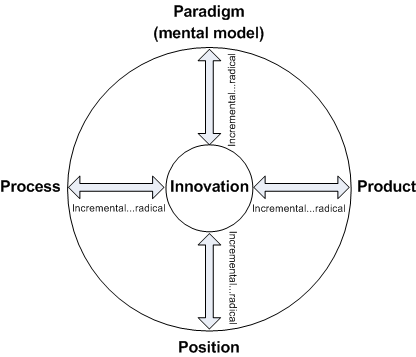When searching literature for definitions of the types of innovation which are most important to firms, three types seem to be widely accepted amongst authors. Mostly referring to the work of Thom, product innovation, process innovation and social/organizational innovation are mentioned (Klein, 2002, p.15; Hübner, 2002, p.14; Tidd et al., 2005, p.10 et sqq.). Often these types affect each other or merge. The development of a new product for example usually goes along with changes in the production process or with organizational change and sometimes even with change in the social system of the firm or its environment. Therefore the identified types of innovation differ and each author tries to draw the borderline between the types according to his/hers focus of argumentation.
Tidd, Bessant and Pavitt supplement the common types by position and paradigm innovation which pays more respect to a changing environment and broadens “innovation spaceâ€. Their suggestion is to put focus on:
• â€product innovation†– changes in the things (products/services) which an organization offers;
• “process innovation†– changes in the way in which they are created and delivered;
• “position innovation†– changes in the context in which the products/services are introduced;
• “paradigm innovation†– changes in the underlying mental models which frame what the organization does.

Fig. 1: Innovation Space
(Source: illustration according to Tidd et al. (2005), p.13)
For the purpose of this work, with its focus on the development of product and process innovations, this categorization of innovation is supposed to provide an overview about the fields of innovation that might be important for firms to explore in order to achieve overall success in innovation management. Overemphasizing one type might provide short time success, but is unlikely to generate sustained long-term advantages over competitors. A sudden (external/or internal) change in one part of the “innovation space†can make a whole lot of efforts put into another part obsolete. This makes the holistic approach of an “innovation space†with its possible variations forming the whole extent of innovation a most suitable model which will therefore be used here.
“Product innovation†means that new goods are delivered to the market as the result of economic activity. Whilst the degree of novelty has already been mentioned before, products in the sense of “result of economic activity†include immaterial output like services as well, which is due to a broader definition of the term (cp. Klein, 2002 p.15). Examples for such products are the light bulb, the steam engine, the typewriter but also a new insurance package or a new home entertainment system (cp. Tidd et al. 2001, p.6-14).
A “process innovation†is an intended change in the process of factor combination within the production process of a firm (cp. Klein, 2002, p.16). Whilst a product innovation is aiming at the output of economic activities, process innovations occur when new technologies and knowledge is first applied on the “manufacturing process†or any other process from which a product (in the sense of: “result of economic activityâ€) emerges. So a process innovation is a change of the methods used to generate a new offering for the market.
“Position innovation†as described by Tidd et al. shows the change of perception of an existing product when putting it into a different context. Their description of a fitness-drink which was formally introduced to the market as a dietary supplement associated by consumers with sickness is a good example for the development of a “new market†or “market innovation†with different consumers. This kind of innovation is likely to be a special challenge for firms’ marketing activities. The same with “Paradigm innovations†that are basically a result of social changes that influence peoples attitudes towards something (e.g. products). Examples are low cost airlines, “designer drinks†or certain online services.
All these types of innovation can possess the mentioned degrees of novelty reaching from incremental to radical.
Radical changes sometimes totally reframe the basis of society or business as shown by the invention of the steam engine which played an important role within the industrial revolution (Tidd et al., 2001, p. 6 et sqq.). The management of Incremental changes in form of continuous improvements has received a lot of attention during the last years. Methods like total quality management, process reengineering, or six sigma suggest, that this theme is not entirely new at all. Usually the main intension of incremental changes is the improvement of quality, speed and productivity. The impact of continuous improvements can often create significant competitive advantages. Radical changes are usually hard to predict and post a certain threat to all established firms whose organizational structures are usually highly adapted to stable markets. Therefore these firms favor incremental changes (Utterback, 1996, p. 83-87). The disruptive impact of technical advance can destroy a firm’s market basis within a very short period of time. Even if the origin, from which a technical change arises, lies in a totally different industry. (The terms radical/disruptive and incremental/evolutionary will be use synonymously in this work)
A firm’s current position and its opportunities influence the choice of innovation strategy. “Path dependencies†limit its capability to change (Tidd et al., 2001, p. 110 et sqq.). As a matter of fact former decisions influence future decisions, and a firm which strongly builds on past investment will not easily change its path in a radical manner. Sometimes disruptive change within a market or product class happens when competitors manage to leave these paths and find new ways of “doing things†or manage to combine techniques in a way which is simply uncommon and unorthodox to this certain market. The TRIZ method for example is one possible way of implementing known “things†in “new†products (cp. http://en.wikipedia.org/wiki/Triz). Often large firms are seen as clumsy giants, unable to adapt to change fast enough because of established organizational boundaries to innovation. But some companies mange the transition from one successful product to the next very well. They adapt to environmental changes fast enough to not being swept away from markets, and some are even “high innovatorsâ€. Examples are GE Medical Systems, Intel, Microsoft, Apple, Ericcson Radio to mention a few (Tushman et al., 1998, p. 29).



 eine große Menge an US-Blogs zu den Themen Innovation, Kreativität, Entrepreneurship usw. und dabei sind mir einige Dinge aufgefallen. (Ich spreche im Folgenden nun verallgemeinernd von „den Amis“ wohl wissend, dass diese Verallgemeinerung an den verschiedenen Stellen eben nicht 100% stimmen mag)
eine große Menge an US-Blogs zu den Themen Innovation, Kreativität, Entrepreneurship usw. und dabei sind mir einige Dinge aufgefallen. (Ich spreche im Folgenden nun verallgemeinernd von „den Amis“ wohl wissend, dass diese Verallgemeinerung an den verschiedenen Stellen eben nicht 100% stimmen mag)